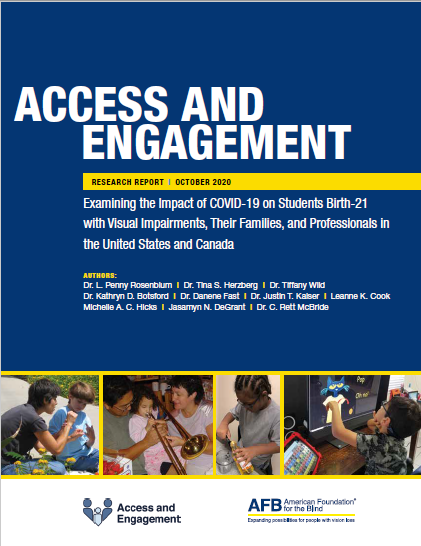Examining the Impact of COVID-19 on Students Birth-21 with Visual Impairments, Their Families, and Professionals in the United States and Canada
Download the Report
Or read the entire report online.
The Access and Engagement report is the culmination of a collaborative survey that investigated the impact of the COVID-19 pandemic on the education of children and youth with visual impairments, including those with additional disabilities and deafblindness.
The 1,432 participants included:
- Family members or guardians of a child with a visual impairment
- Teachers of students with visual impairments (TVIs)
- Orientation and mobility (O&M) instructors
Data were collected from families and guardians whether or not their child was currently receiving educational services. Professionals provided input even if they were not currently serving students due to the COVID-19 pandemic. The survey explored the non-traditional delivery of educational services by TVIs and O&M instructors.
Executive Summary
The Executive Summary provides an overview of the study findings and key recommendations.
Download the Executive Summary
The more than 100-page full report includes information on 62 children receiving early intervention services, 60 children receiving preschool services, and 333 children who are school-aged or in transition. In addition, data from 1,028 TVIs and O&M specialists are provided.
Each section of the report contains recommendations for families, educators, administrators, and policymakers. We want to know how you are using the report. Email us at access_report@afb.org and use the hashtag #AccessEngagement to share your thoughts, ideas, and collaborative efforts to improve education for our students with visual impairments.
Sharing the Access and Engagement Findings
The research team has been sharing the results in multiple ways:
- Dr. Rosenblum reported the findings at the American Printing House for the Blind’s 152nd Annual Meeting on October 8, 2020
- Dr. Rosenblum joined the Blind Abilities podcast to discuss how the COVID-19 pandemic is impacting educational services for children birth to 21 years of age and their families
- Dr. Rosenblum spoke recently with Paul Olson, president of the Council of Schools and Services for the Blind (COSB)
- AFB shared its School Reopening Principles for Blind and Low Vision Students with Congress and other decision-makers
How Will the Data Be Used?
The data will be used to allow educators, administrators, policy makers, and families to better understand the challenges and successes students with visual impairments, including those with additional disabilities and deafblindness, are experiencing when educational services are being delivered in unique ways. We hope to identify novel ways families and educators are working together to provide instruction in the expanded core curriculum. We want to document how TVIs and O&M instructors who don’t have access to all of their materials and resources are providing instruction in unique ways.
For example:
How are O&M instructors advancing students’ O&M skills when they aren’t able to travel with them in the community?
How are TVIs guiding their students to build independence in the kitchen when they typically would model new skills using hand-under-hand techniques?
How is a child who responds best to having the teacher demonstrate hand positioning for braille reading responding to a verbal description?
How is the TVI supporting a student in accessing general education or special education classes being taught online?
The Second Access & Engagement Study
We have just completed data collection for the Second Access & Engagement Study to explore the continued impact of the COVID-19 pandemic on the education of students with visual impairments, including those with additional disabilities and deafblindness. A final report will be available in the spring.
Study Collaborators
The following 19 organizations, companies, and universities are collaborating on this project.
- Academy for Certification and Education of Vision Rehabilitation Professionals
- Aira Tech Corp
- American Council of the Blind
- American Foundation for the Blind
- American Printing House for the Blind
- Association for Education and Rehabilitation of the Blind and Visually Impaired
- CNIB Foundation
- Council for Exceptional Children’s Division on Visual Impairment and Deafblindness
- Council of Schools and Services for the Blind
- Humanware
- National Braille Press
- National Organization for Albinism and Hypopigmentation
- Objective Ed
- Perkins School for the Blind
- Seedlings Braille Books for Children
- Texas School for the Blind and Visually Impaired
- University of South Carolina Upstate, Visual Impairment Program
- Vision Loss Rehabilitation Canada
- VisionServe Alliance
- Vispero
Learn more about Dr. L. Penny Rosenblum, AFB's director of research
